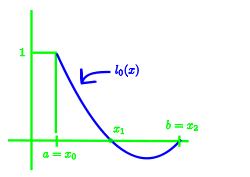|
page10-1
HW2.9:Use (1) p.8-1 to generate P5(x),
and matlabl command"roots"to comp.
the roots of P5(x)to check values in table
on p. 7-5. Plot the roots on [-1,+1] using
matlab "plot" command (plot dots "."
with coordinator (xi,yi), i = 1,...,5 : use "markersinge" 15)
xi: roots of P5(x)
yi:
Plot (x, y, '.' , 'markersige' , 15)
Repeat the above for P10(x)
observe the location of the roots near end points -1 and +1
(prepare for Runge phenomenon)
NOTE:
Lagrange interp. cont'd p.9-4
page10-2
Simpson's rule (simple)
![{\displaystyle [a,b]\ x_{0}=a,\ x_{1}={\frac {a+b}{2}},\ x_{2}=b\ \color {red}(1)}](https://wikimedia.org/api/rest_v1/media/math/render/svg/f3197a1d8fa15eebdf1ba693f3d8e2b392e0b237)

c0, c1, c2 unknowns
p2=(xi) = f(xi) i= 0, 1, 2 (3)
3 equations for 3 unknowns {ci}
Method 2:Use lagrangeinterp.(2) p.8-3 (1) p.9-2

Equiv. of meth1 and meth 2: (3)

page10-3

It can be verified that
l0(x0)=1 , l0(x1) = l0(x2) = 0
li(xj) = δij i,j = 0. 1. 2



page10-4


HW*2.10: Use(2) & (3)p.10-2 to find
expression for {ci} in terms (xi, f(xi)) i=0,1,2.
HW*2.11: Use (4) p.10-2 to
derive simple Simpson's rule
HW*2.11:f(x)-ex1/x on [o,1] S10and on [-1,1]S11
Consider n=1(Trap), 2(Simp), 4, 8, 16
page10-5
Constrast fn(x) as in (2) p.8-3.
Plot f , fn , n= 1, 2, 4, 8, 16
Compare 
n=1, 2, 4, 8
and compare to I (use WA with more digits)
For n=5 plot l0, l1, l2 How would l3, l4, l5 look like?
HW*2.13:show


| 
![{\displaystyle [a,b]\ x_{0}=a,\ x_{1}={\frac {a+b}{2}},\ x_{2}=b\ \color {red}(1)}](https://wikimedia.org/api/rest_v1/media/math/render/svg/f3197a1d8fa15eebdf1ba693f3d8e2b392e0b237)











